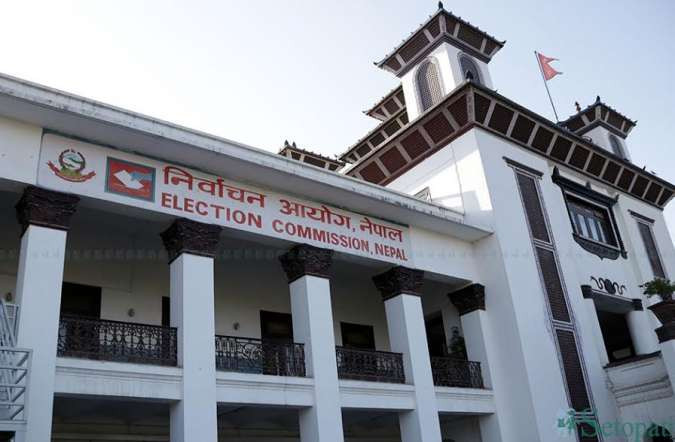The Election Commission has given candidates 39 days to campaign for the provincial and federal elections to be held on November 20 even as countries across the world are cutting campaign period to reduce expenses.
India gives just 14 days for Lok Sabha elections that have constituencies with 300,000 to 3 million voters. France gives a maximum of two weeks for election campaigning, Japan 12 days and Singapore just nine days.
Everyone from politicians to former and current Election Commission officials agree that a longer period for campaigning increases cost of the candidates. Leaders of all the major parties concur that a candidate has to spend in tens of millions to get elected in parliamentary elections.
Addressing a program in April Nepali Congress (NC) leader Shashank Koirala had claimed that he spent Rs 80,000 in the first general election he contested, Rs 30 million in the second and Rs 60 million in the third and last one in 2017. Video of his statement was widely shared on the social media even though he said he was giving the expense details while thrice contesting from Nawalparasi-1 off the record.
The Election Commission, that had set a limit of Rs 2.50 million for the last general election, even sought explanation pointing that Koirala in his submission to the Election Commission revealed that he spent Rs 2.175 million.
CPN-UML leader Ghanashyam Bhusal concedes that the average cost for contesting the upcoming federal election may rise up to Rs 40 million for each candidate.
Political leaders from all parties agree that contesting elections is becoming prohibitively expensive for any candidate with integrity who is not filthy rich, and significantly cutting the campaign period can reduce those expenses.
But the Election Commission says it cannot cut the campaign period in the current situation citing the time needed for printing ballots and transporting them to the polling centers across the country.
“We gave only around 15 days for campaigning in the local election. Printing just 20 million ballots was sufficient then. We have to print 80 million ballots for provincial and federal elections this time,” Election Commission Spokesperson Shaligram Sharma Paudel told Setopati.
Former chief election commissioner (CEC) Bhoj Raj Pokharel points that ballots are currently printed only at the center and transported across the country, and adds that printing ballots at the district level will cut the time for printing thereby shortening the period alloted for campaigning.
Current CEC Dinesh Kumar Thapaliya blames the political parties who accuse the Election Commission of secretly providing ballots to a particular party to facilitate vote-rigging even when ballots are printed only at the center under strict security provided by the Nepal Army.
He, however, says printing at the district level is not possible even if the parties were to trust the process and adds that the best hope is to print at the provincial level. But printing ballots even at the provincial level is a distant dream now as there is no government printing press outside the Kathmandu Valley.
He stresses that corruption allegations are made even when ballots are printed at the government press and points that printing them at multiple private presses across the country would attract more such allegations as the cost of printing in private presses will be more expensive than doing so in a government press.
Using electronic voting machines (EVM) can do away with the time needed for printing the ballots while also making vote counting far easier to deliver election results in a day instead of weeks it took in the recent local election.
Former CEC Pokharel proudly points how the Election Commission under him had used EVMs in six constituencies in the First Constituent Assembly Election in 2008 and rues that his successors at the Election Commission did not pursue use of EVMs enthusiastically.
But CEC Thapaliya begs to differ and counts problems in using EVMs. He points that using EVMs would raise the cost of upcoming election from estimated Rs 8 billion to Rs 14 billion. He reveals how the Election Commission in India manufactures the EVMs itself and also carry out the repair and maintenance works in a large country where elections are held in one or other states almost every year, adds that Bangladesh also does so, and concedes that the Election Commission can also do something similar in Nepal.
But he points at lack of trust on reliability of the EVMs as the biggest factor in stopping use of electronic voting. Election Commission Spokesperson Shaligram Sharma Paudel points that there are genuine fears that votes cast for one party can be diverted to another through tampering or hacking of EVMs pointing how systems of commercial banks in Nepal have been hacked to siphon off money. He states that use of EVMs cannot be mulled until some government authority guarantees about their absolute reliability.
“Using EVMs is a good option but our study has showed that a few countries have reverted to ballots from EVMs. That makes it seem as if the questions about its reliability/security are genuine,” CEC Thapaliya adds.
He acknowledges that opting for EVMs would be a huge leap for Nepal but reminds that it will not be possible this year. “The best we can hope is taking printing of ballots for federal and provincial elections to the provinces, and those for local elections to the districts. The private sector may have the machines and tools required to take printing to the provinces even now but we need an environment of trust for that.”

